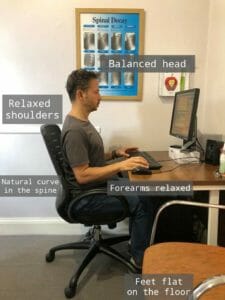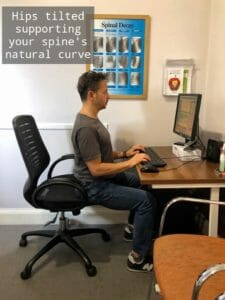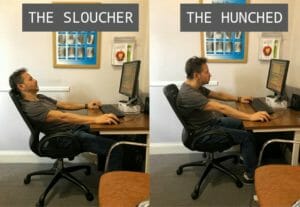
This body didn’t evolve from our highly active ancestors to sit at a desk eight hours a day. We’re just not adapted for it, and that’s why sitting is almost the new smoking.

As chiropractors, we’re concerned with the musculoskeletal effects of a sedentary lifestyle. Sitting weakens our leg muscles and glutes (bum muscles) and shortens our hip flexors, meaning we can be more prone to injury. Poor posture also often leads to stiffness in the neck, shoulders and back. This can add uneven pressure to the discs and lead to premature degeneration of the spine.
Since Covid took over like a zombie apocalypse, many of us still work from home even after lockdown. So, if we’re going to spend so much time on our backside, here are some simple tips, straight from our chiropractors, to set up an ergonomic home office and reduce the strain on your body.
First off, and this might seem obvious, don’t work from your bed, couch or floor. Home office, still has the word office in it. You need to sit upright working from a table or desk to correctly support your spine.
Setting-up an Ergonomic Home Office
Adjust your seat height

Your shoulders should be relaxed. If you feel like you’re tensing your shoulders, then your seat is probably too high. You shouldn’t need to reach too far for your keyboard. Ideally your forearms should be almost parallel with the ground.
Position your screen
Set your screen up so that it is directly in front and your eyes are in line with the upper half of the monitor.
If you’re working from a laptop, we highly recommend investing in a keyboard and mouse. It will make the world of difference! You can then use your laptop as a screen and adjust it to the right height.
Backrest or no backrest?

This is entirely up to you. You can use a backrest as long as you’re not slouching. To avoid this, your upper back shouldn’t be in contact with the chair, but it should maintain the lordosis curvature in your lower back.
Alternatively you can sit further forward on the chair with your hips slightly tilted, which naturally supports the curve in your spine.
Legs
Your thighs should be at a 90-degree angle to your body, and your feet should lie flat on the floor. Simply resting your toes on the floor isn’t enough! So if you’re on the short side, first adjust your seat height so that you’re comfortable in front of the table, position the screen correctly, and then simply use a footrest to bring your knees up to a comfortable height.
Our chiropractors also advise against leaning on the desk with your elbows or feet! Sustaining weird postures throughout the day will generate musculoskeletal pain. We haven’t evolved over the past 10 000 years to stay seated for long periods of time so it’s normal that you might fidget or want to adjust, slouch, lean or change posture. Take a break from time to time and set a small reminder encouraging you to stretch for five minutes every half hour.


